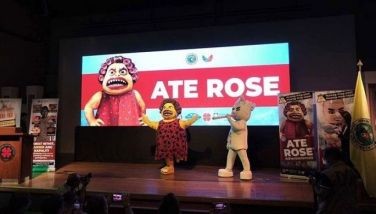SSC marks centennial
December 7, 2005 | 12:00am
Next year will round out a century of Benedictine missionary presence in the Philippines. On Sept. 10, 1906, four Benedictine nuns and a novice arrived in Manila from Tutzing, Germany.
Their first residence was on Moriones Street, Tondo, a very poor section of the city. In December, they opened a school for the first three grades with two boys and six girls from well-to-do families, and 50 boys and girls in the "Free School" – a wagon-shed with no windows. The number of students rapidly grew and the nuns moved to San Marcelino Street on the eve of Christmas 1907. The school was now officially called St. Scholastica’s College.
Sr. Willibalda Schroder guided it for the next 30 years. Giving substance and meaning to the motto Ora et Labora (Work and Pray), she and her co-workers gained for the school of reputation not only for academic excellence but also for community service.
In 1907, Sr. Baptista Battig arrived from Germany to pioneer in formal music education in the Philippines. Before entering the nunnery, she was a society debutante and a concert pianist who had studied under Ludwig Deppe, the last of Liszt’s pupils. Sr. Battig began teaching in a room in Singalong with two donated pianos. With the passing of the years, the music school expanded.
In 1932, St. Cecilia’s Hall was built: its architect, Andres Luna San Pedro, son of Juan Luna and Paz Pardo de Tavera, introduced Art Deco in the Philippines. Remodelled recently after having been destroyed in World War II, St. Cecilia’s Hall is now an ideal venue for the performing arts with its excellent acoustics, sight-lines, air-conditioning, enlarge kamagong orchestra pit, 17 fly lines, dressing rooms for men and women, an elegant foyer-lobby and 950 cushioned seats.
It is a dream come true for Sr. Battig to whom every Filipino musical artist, every college and institution in the country that offers music courses owes his/her/its beginnings, directly or indirectly, to the pioneering efforts of Sr. Battig. In pre-war years, interns (myself included) were allowed to attend graduation piano recitals (with or without orchestral accompaniment) at St. Cecilia’s Hall, to deepen our appreciation for classic music.
Believe it or not, in that hall, I performed as the partner of a Russian Cossack and of a Mexican country boy, as a Persian maiden and a Geisha, in the latter two, sur les pointes! I had the privilege of studying under graduates of Sr. Battig: Barbara Cuaycong, Blanca Castillo Dinglasan – who incredibly gave concerts up to the ripe age of 94! – the sisters Agoncillo, Marcela and Eugenia, the latter having given me valuable pointers in music criticism. (Incidentally, I owe her a debt of gratitude for the international awards I have received for my critiques.)
I have wonderful memories of attending and reviewing concerts given in St. Cecilia’s Hall by such world-acclaimed artists as the legendary cellist Gregor Piatigorsky, Metropolitan Opera singers Jan Peerce, Blanche Thebom, Eleanor Steber, Wagnerian soprano Helen Traubel, pianists Gary Graffman and Rudolf Serkin, and the incomparable black contralto Marian Anderson.
The late choreographer, National Artist Leonor Orosa Goquingco who graduated summa cum laude (B.S.E.) from SSC, staged full-length programs in St. Cecilia’s Hall: "Circling the Globe" and "Dance Panorama" in which latter recital Sr. Soledad Hilado performed as a college student.
Under the dynamic and enterprising deanship of Sr. Mary Placid Abejo, the College of Music has expanded its curriculum, offering courses not only in piano and voice but also in winds and strings. It organized PREDIS (Philippine Research for Developing Instrumental Soloists); many of its scholarships have been extended to disadvantaged children whose talent has been discovered at an early stage and accordingly given an opportunity to develop.
In over-all education, the SSC is the lead institution in two research projects: 1) Aligning Competency Skills of Information and Communication Technology (ICT) Graduates and Industry Needs; 2) Comparative Study of Traditional and Problem-based Learning Methods in Teaching Business Subjects.
Masteral degrees are now offered in Education (SPED, Pre-School Education/Pre-School Management)/ Music (Piano Pedagogy, Music Education), Family Psychology and Counseling, Hotel and Restaurant Management, Accountancy, Business Management and Women’s Studies.
SSC has started the Institute for Emerging Technologies and the Institute for Catering Management and Hospitality Technology. The school has taken a step forward towards greater utilization of technology in the teaching-learning process. Another innovation in technology is the in-house development of an Integrated School Information System in support of an effective administrative system.
Through a century, the school which offered three first grades in a room in Tondo has grown into a vast institution offering the most advanced and sophisticated courses. SSC on Leon Guinto St. has now more than 6,000 students, with the Sisters numbering about 140 in 19 communities, including one in Western Australia. They have 12 schools with around 30,000 students, one hospital, three immersion communities among the poor, one spirituality center, one ecological farm and a refuge house for battered women and abused children. All communities and institutions are engaged in socio-pastoral apostolate.
SSC alumnae include Cory Aquino, the Republic’s first woman president, Vicky Quirino, President Elpidio Quirino’s daughter, and Josie Lichauco, outstanding government official. In a sense, all artists whose music education reflects the foundation laid down by Sr. Battig are SSC alumni: Sunico, C. Licad, R. Arrieta, the Bolipatas, O. Yatco, G. Kabayao, C. Coyuito, I. Sta. Maria, R. Reyes, M. Maramba, O. Gonzaga, N. Cabahug, A. Fernandez, R. Gerodias and scores more.
Their first residence was on Moriones Street, Tondo, a very poor section of the city. In December, they opened a school for the first three grades with two boys and six girls from well-to-do families, and 50 boys and girls in the "Free School" – a wagon-shed with no windows. The number of students rapidly grew and the nuns moved to San Marcelino Street on the eve of Christmas 1907. The school was now officially called St. Scholastica’s College.
Sr. Willibalda Schroder guided it for the next 30 years. Giving substance and meaning to the motto Ora et Labora (Work and Pray), she and her co-workers gained for the school of reputation not only for academic excellence but also for community service.
In 1907, Sr. Baptista Battig arrived from Germany to pioneer in formal music education in the Philippines. Before entering the nunnery, she was a society debutante and a concert pianist who had studied under Ludwig Deppe, the last of Liszt’s pupils. Sr. Battig began teaching in a room in Singalong with two donated pianos. With the passing of the years, the music school expanded.
In 1932, St. Cecilia’s Hall was built: its architect, Andres Luna San Pedro, son of Juan Luna and Paz Pardo de Tavera, introduced Art Deco in the Philippines. Remodelled recently after having been destroyed in World War II, St. Cecilia’s Hall is now an ideal venue for the performing arts with its excellent acoustics, sight-lines, air-conditioning, enlarge kamagong orchestra pit, 17 fly lines, dressing rooms for men and women, an elegant foyer-lobby and 950 cushioned seats.
It is a dream come true for Sr. Battig to whom every Filipino musical artist, every college and institution in the country that offers music courses owes his/her/its beginnings, directly or indirectly, to the pioneering efforts of Sr. Battig. In pre-war years, interns (myself included) were allowed to attend graduation piano recitals (with or without orchestral accompaniment) at St. Cecilia’s Hall, to deepen our appreciation for classic music.
Believe it or not, in that hall, I performed as the partner of a Russian Cossack and of a Mexican country boy, as a Persian maiden and a Geisha, in the latter two, sur les pointes! I had the privilege of studying under graduates of Sr. Battig: Barbara Cuaycong, Blanca Castillo Dinglasan – who incredibly gave concerts up to the ripe age of 94! – the sisters Agoncillo, Marcela and Eugenia, the latter having given me valuable pointers in music criticism. (Incidentally, I owe her a debt of gratitude for the international awards I have received for my critiques.)
I have wonderful memories of attending and reviewing concerts given in St. Cecilia’s Hall by such world-acclaimed artists as the legendary cellist Gregor Piatigorsky, Metropolitan Opera singers Jan Peerce, Blanche Thebom, Eleanor Steber, Wagnerian soprano Helen Traubel, pianists Gary Graffman and Rudolf Serkin, and the incomparable black contralto Marian Anderson.
The late choreographer, National Artist Leonor Orosa Goquingco who graduated summa cum laude (B.S.E.) from SSC, staged full-length programs in St. Cecilia’s Hall: "Circling the Globe" and "Dance Panorama" in which latter recital Sr. Soledad Hilado performed as a college student.
Under the dynamic and enterprising deanship of Sr. Mary Placid Abejo, the College of Music has expanded its curriculum, offering courses not only in piano and voice but also in winds and strings. It organized PREDIS (Philippine Research for Developing Instrumental Soloists); many of its scholarships have been extended to disadvantaged children whose talent has been discovered at an early stage and accordingly given an opportunity to develop.
In over-all education, the SSC is the lead institution in two research projects: 1) Aligning Competency Skills of Information and Communication Technology (ICT) Graduates and Industry Needs; 2) Comparative Study of Traditional and Problem-based Learning Methods in Teaching Business Subjects.
Masteral degrees are now offered in Education (SPED, Pre-School Education/Pre-School Management)/ Music (Piano Pedagogy, Music Education), Family Psychology and Counseling, Hotel and Restaurant Management, Accountancy, Business Management and Women’s Studies.
SSC has started the Institute for Emerging Technologies and the Institute for Catering Management and Hospitality Technology. The school has taken a step forward towards greater utilization of technology in the teaching-learning process. Another innovation in technology is the in-house development of an Integrated School Information System in support of an effective administrative system.
Through a century, the school which offered three first grades in a room in Tondo has grown into a vast institution offering the most advanced and sophisticated courses. SSC on Leon Guinto St. has now more than 6,000 students, with the Sisters numbering about 140 in 19 communities, including one in Western Australia. They have 12 schools with around 30,000 students, one hospital, three immersion communities among the poor, one spirituality center, one ecological farm and a refuge house for battered women and abused children. All communities and institutions are engaged in socio-pastoral apostolate.
SSC alumnae include Cory Aquino, the Republic’s first woman president, Vicky Quirino, President Elpidio Quirino’s daughter, and Josie Lichauco, outstanding government official. In a sense, all artists whose music education reflects the foundation laid down by Sr. Battig are SSC alumni: Sunico, C. Licad, R. Arrieta, the Bolipatas, O. Yatco, G. Kabayao, C. Coyuito, I. Sta. Maria, R. Reyes, M. Maramba, O. Gonzaga, N. Cabahug, A. Fernandez, R. Gerodias and scores more.
BrandSpace Articles
<
>
- Latest
- Trending
Trending
Latest
Trending

By GOTCHA | By Jarius Bondoc | 5 hours ago

By EYES WIDE OPEN | By Iris Gonzales | 1 day ago

By C-TALK | By Cito Beltran | 5 hours ago
Recommended



























